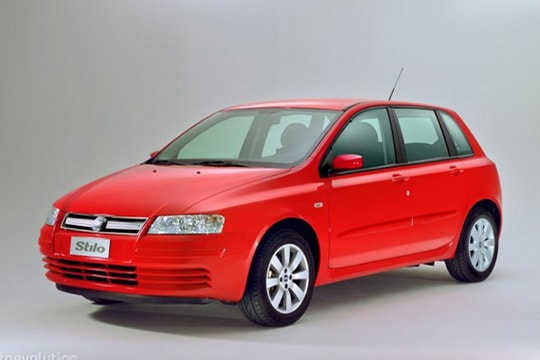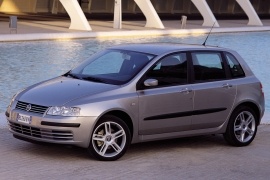FIAT Stilo 5 Doors Models/Series Timeline, Specifications & Photos
First production year: 2001
Engines: Gasoline, Diesel
Body style: Hatchback
At the end of 2003, Fiat introduced a facelift for the Stilo lineup, improving the car in many ways and trying to increase sales in the European market.
The Stilo debuted at the 2001 Geneva Motor Show, with sales starting in September of the same year. By 2003, the Italian automaker had already sold 175,000 units of the five-door Stilo in Europe. At first sight, it didn’t look that impressive, but it was above the average in the car segment. Furthermore, the sales of 125,000 units of its three-door sibling plus 50,000 units of the station wagon version ensured Fiat that the car was doing well on the market. However, that didn’t stop the car manufacturer from refreshing the lineup for the 2004 model year, improving it in many key aspects, including the onboard technology, comfort features, exterior and interior design, and drivetrains. As expected, the five-door model was the most sought-after version of the Stilo since it provided enough room for a family of four and didn’t break the bank with its acquisition price or running costs.
When it came to design, the Italians knew where and what to change on a vehicle to make it look fresh, even though there were just mild updates. As a result, the car’s front fascia went through some changes, which involved a new grille that featured a silver horizontal slat and a matching color rim that surrounded it. In addition, the clear-lenses headlights were on par with the latest trends on the market. At the same time, the lower bumper was entirely new and sported two horizontal slats that ran across the entire width, covering the center air intake and the side scoops.
From its profile, it was challenging to say if the 2004 Stilo was new or not since it featured the same design, albeit with some changes. But still, it had clear turn signal lamps on the front fenders. In addition, Fiat added body-colored rubber protections on the doors to protect the bodywork from shopping carts. Just like its predecessor, it had body-colored door handles and mirrors. The car manufacturer noticed the increased interest of its customers in alloy wheels, so it provided them with new designs. Another upgrade was seen on the rear part of the car, where the five-door version, where the Fiat Style Centre designers redesigned the tailgate and removed the bumper grooved. At the same time, the fog lamps were integrated into the redesigned taillights. Previously, they were next to the license plate.
Inside, the automaker focused on improving the driving experience and the comfort of the car’s occupants. The high-mounted seats and roomy cabin made customers feel like they were inside a spacious MPV, albeit it was just a slightly taller hatchback. The automaker added an option for white dials and red needles for the instrument cluster, similar to those installed in the Abarth version. Another crucial update was the introduction of a boiler-type pre-heather for diesel versions, which could be programmed so customers could enjoy a warm cabin right after they started their vehicles.
Under the hood, Fiat dropped the 1.2-liter engine from the lineup. The base version was fitted with a new 1.4-liter 16-valve powerplant that provided 15 more PS (15 hp) than the 1.2-liter one. A punchier 115 PS (114 hp) turbodiesel with an intercooler was added to the range, improving performance and fuel efficiency.
Fiat replaced its aging Bravo/Brava compact-sized hatchback with the Stilo, a vehicle that it revealed at the 2001 Geneva Motor Show.
The compact segment was among the most grueling in the European market. All the leading mass-market automakers had one vehicle that could fit there, from Audi with the A3 to Volkswagen with its notorious Golf. Moreover, even premium automakers, such as BMW and Mercedes-Benz, had something to offer with their 3 Series Compact and the C-Class Sportcoupe, respectively. But then, the Italians had other customers in mind: those willing to spend their hard-earned money on a brand-new car big enough to accommodate a family of four and move them around in the fuel-efficient Stilo. Their idea wasn’t bad at all, especially since the five-door Italian hatchback provided more than anyone else on the market. In addition, those willing to spend more could get the vehicle fitted with punchier engines, but without breaking the bank.
With the new-edge design almost over, the Italians imagined a vehicle with a front fascia dominated by angles and straight lines. The headlights, for instance, were rectangular with corner-mounted turn signals. In the middle, the grille sported three horizontal slats, and the carmaker’s badge took center stage. On the lower part of the bumper, the automaker placed a second air intake.
From its profile, the five-door Stilo impressed customers with its large glass areas for the tall greenhouse. Furthermore, Fiat also added a third row of windows behind the rear doors. The automaker didn’t want its car to look too cheap, so it installed body-colored door mirrors and handles. Depending on the trim and options, the 2001 Fiat Stilo five-door could be ordered with either steel or light alloy wheels. At the back, the tailgate was just slightly tilted forward and was flanked by angular-shaped corner-mounted taillights.
Inside, the Stilo was roomy enough for five adults, albeit the bench seat in the back was mostly useful for two persons. Fiat didn’t want to provide its newest creation with just a ventilation system. As a result, it provided the Stilo with air-conditioning. In addition, the car also came fitted with a decent enough sound system. The instrument cluster fronted the driver and was filled with large dials for the tachometer and speedometer, while on the lower side was an LCD that showed the odometer and other data from the car’s onboard computer. In addition, on the upper side, Fiat installed small gauges for the fuel level and coolant temperature.
Under the hood, Fiat installed a choice of gasoline and diesel engines ranging between 80 PS (79 hp) and 170 PS (168 hp) paired with either a five- or a six-speed manual. As an option, customers could get the five-speed Selespeed automated transmission (single-clutch).

